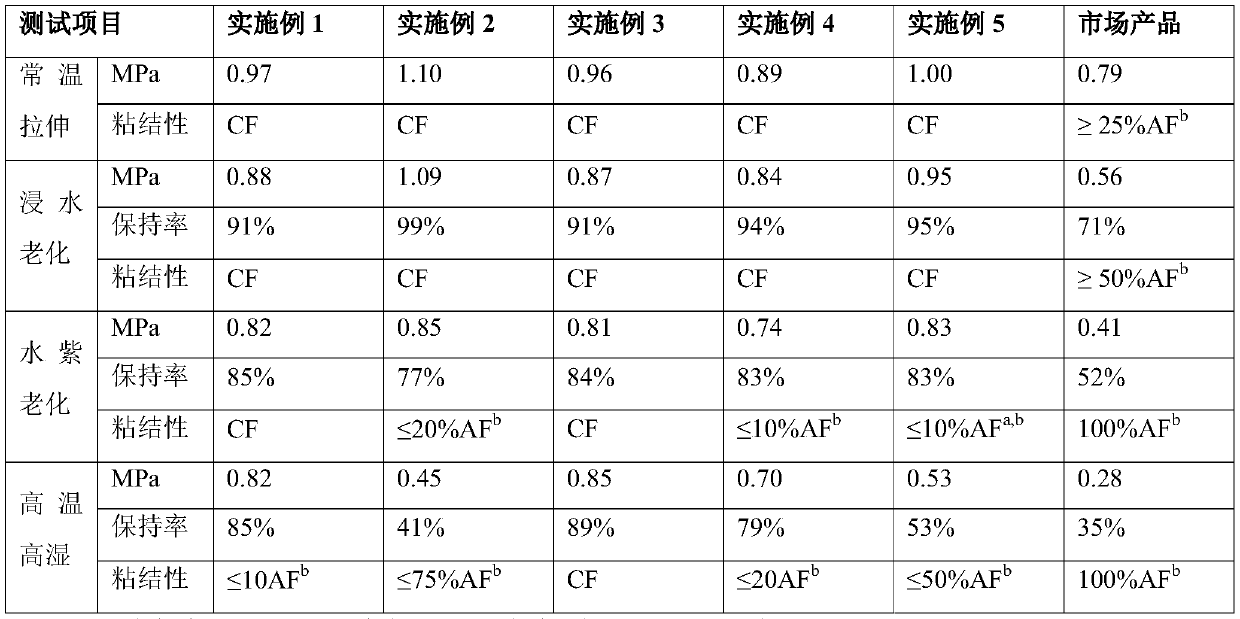Two-component organic silicon sealant and application thereof in LOW-E hollow glass
A silicone and sealant technology, used in adhesives, adhesive additives, non-polymer adhesive additives, etc., can solve the problems of poor bonding stability and low strength retention rate, and achieve stable bonding strength and high viscosity. The effect of contact strength retention
- Summary
- Abstract
- Description
- Claims
- Application Information
AI Technical Summary
Problems solved by technology
Method used
Image
Examples
Embodiment 1
[0021] Low-E two-component silicone sealant for insulating glass is composed of the following raw materials in parts by mass:
[0022] Component A: 26 parts of hydroxyl-terminated polydimethylsiloxane with a viscosity of 20000mPa·s, 20 parts of hydroxyl-terminated polydimethylsiloxane with a viscosity of 80000mPa·s, and hydroxyl-terminated polydimethylsiloxane with a viscosity of 50mPa·s 1.5 parts of base silicone oil and 52.5 parts of active nano-calcium carbonate are stirred evenly in a mixing and stirring device;
[0023] Component B: R 1 For methyl, ethyl, propyl, methoxy, ethoxy and R 2 Combination of 21 parts of methyl and ethyl cross-linking agents, R 3 Aminopropyl, (2,3-epoxypropoxy)propyl, (2-aminoethyl)-3-aminopropyl and R 4 19 parts of methyl and ethyl coupling agent combinations, 15 parts of carbon black, 45 parts of simethicone oil with a viscosity of 350 mPa s and 0.2 parts of dicaprate tin diformate, and stir evenly in a mixing and stirring device under vacuu...
Embodiment 2
[0026] Low-E two-component silicone sealant for insulating glass is composed of the following raw materials in parts by mass:
[0027] Component A: 24 parts of hydroxyl-terminated polydimethylsiloxane with a viscosity of 6000mPa·s, 16 parts of hydroxyl-terminated polydimethylsiloxane with a viscosity of 80000mPa·s, and dimethyl silicone oil with a viscosity of 350mPa·s 5 parts and 55 parts of active nano-calcium carbonate, stir in mixing and stirring equipment;
[0028] Component B: R 1 For methyl, ethyl, propyl, phenyl, methoxy, ethoxy and R 2 Combination of 25 parts of cross-linking agent for methyl, ethyl and phenyl, R 3 Aminopropyl, (2,3-epoxypropoxy)propyl, (2-aminoethyl)-3-aminopropyl and R 4 Combination of 25 parts of methyl and ethyl coupling agent, 13 parts of carbon black, 36.5 parts of simethicone oil with a viscosity of 350 mPa s and 0.5 part of dibutyltin dilaurate, and stir evenly in a mixing and stirring device under vacuum ;
[0029] At room temperature, c...
Embodiment 3
[0031] Low-E two-component silicone sealant for insulating glass is composed of the following raw materials in parts by mass:
[0032] Component A: 26 parts of hydroxyl-terminated polydimethylsiloxane with a viscosity of 20000mPa·s, 26 parts of hydroxyl-terminated polydimethylsiloxane with a viscosity of 80000mPa·s, and hydroxyl-terminated polydimethylsiloxane with a viscosity of 50mPa·s 1.5 parts of base silicone oil and 46.5 parts of active nano-calcium carbonate are stirred evenly in a mixing and stirring device;
[0033] Component B: R 1 For methyl, ethyl, propyl, methoxy, ethoxy and R 2 Combination of 19 parts of methyl and ethyl cross-linking agents, R 3 Aminopropyl, (2,3-epoxypropoxy)propyl, (2-aminoethyl)-3-aminopropyl and R 4 Combining 21 parts of methyl and ethyl coupling agents, 15 parts of carbon black, 45 parts of simethicone oil with a viscosity of 350 mPa·s and 0.2 parts of dicaprate tin diformate, and stir evenly in a mixing and stirring device under vacuum;...
PUM
| Property | Measurement | Unit |
|---|---|---|
| viscosity | aaaaa | aaaaa |
| viscosity | aaaaa | aaaaa |
| viscosity | aaaaa | aaaaa |
Abstract
Description
Claims
Application Information
 Login to View More
Login to View More - R&D
- Intellectual Property
- Life Sciences
- Materials
- Tech Scout
- Unparalleled Data Quality
- Higher Quality Content
- 60% Fewer Hallucinations
Browse by: Latest US Patents, China's latest patents, Technical Efficacy Thesaurus, Application Domain, Technology Topic, Popular Technical Reports.
© 2025 PatSnap. All rights reserved.Legal|Privacy policy|Modern Slavery Act Transparency Statement|Sitemap|About US| Contact US: help@patsnap.com

